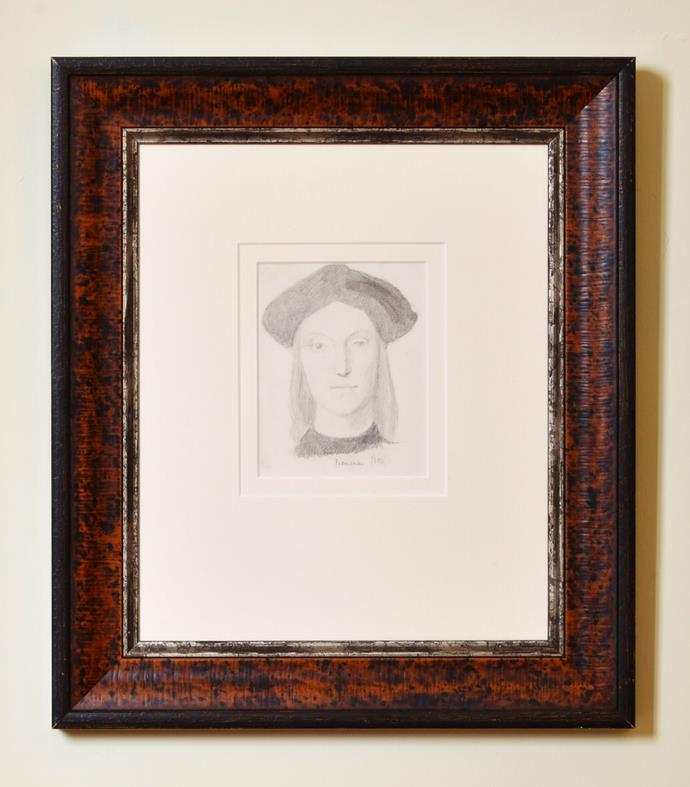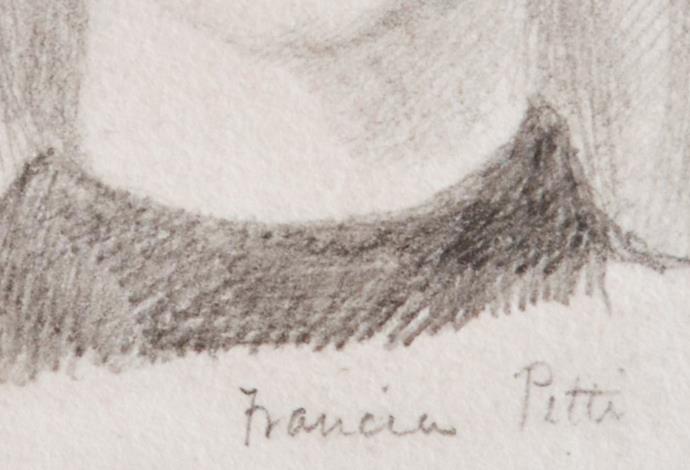Portrait Study of 'Guidobaldo da Montefeltro' after Raphael Valentine Cameron Prinsep
This compelling little portrait drawing, accompanied by the words, ‘Francia Pitti’, has been the start of a fascinating journey of discovery. Was it definitely by Prinsep? What date might it have been drawn? And who might be the model?
The picture has been through the reliable hands of Abbott and Holder and that is reassuring. A comparison with other Prinsep drawings - notably, the collection held by the British Museum ‘dated from around 1859 many of which were copies after Renaissance artists’ - confirms the handwriting. So far, so good. But, who or what was ‘Francia Pitti’? We scoured the web. A humanist scholar? A member of the redoubtable Pitti family? We pursued a number of dead ends. There was also, however, a tasty line of crumbs, leading us to what we believe to be the reward.
Prinsep and Burne-Jones travelled together to Italy in 1859, making studies after Renaissance works of art. They called on Robert and Elizabeth Browning, with a letter of introduction from Rossetti and we know that they all spent time in Siena, Florence and Rome. Indeed, Browning wrote to their mutual friend, Leighton, reporting on their meeting. During the early 1850s, we also know that Leighton was making numerous pencil studies of Old Masters, in Italy. Leighton valued these works and displayed some of them in his studio. It could well have been there, in London - before he set off for Italy - that Val Prinsep encountered these drawings, variously inscribed, ‘Cimabue Uffizi’, ‘Masaccio Uffizi’, ‘Titian Pitti’. And so, to Val Prinsep’s drawing, ‘Francia Pitti’.
Francesco Francia (d.1517) was a significant Bolognese artist, a painter of devotional pictures, inspired by the work of Perugino – whose most famous pupil was Raphael. So – was Prinsep’s drawing after a portrait by Francia? And was this portrait in the Palazzo Pitti in 1859, when Prinsep was in Florence? Wonderfully, online, one can now find The Art of The Pitti Palace: With A Short History of The Building of The Palace, and Its Owners, written by American-born Julia de Wolf Gibbs Addison and published in 1903. And, herein, I believe we can identify the model for the Prinsep drawing.
‘A mediaeval, serious countenance gazes at us from a small panel, Number 195, by Francia … It is as fine a treatment of a human face as any in this gallery, and stands out cool, restful, and pure from among the florid pictures of a later day. Francia … was a great artist who lived in the early part of the sixteenth century… His work has a fascinating quality of naïveté…’.
It is not at all surprising that this austere head would have appealed to any artist associated with the Pre-Raphaelite Brotherhood in the 1850s. One can certainly see the ‘family’ likeness to the stare - at once ascetic, intense and even sensuous - in numerous PRB paintings: in Rossetti’s and Burne-Jones’s portraits of Jane and Georgiana and in many of Prinsep’s portraits of women, including the provocatively titled, Unprofessional Beauty, at the Grosvenor Gallery in 1880.
Our quest, however, was not quite complete. A continuing search through many Renaissance portraits had accompanied us during this journey of discovery. And, here it was: unquestionably, the original portrait is now in the Uffizi and, in 2022, Italian art historian Cristina Acidini confirmed that Raphael, not Francia, painted the last descendant of the Montefeltro dynasty in 1506. And, studying in the Palazzo Pitti, in Florence, probably in 1859, Val Prinsep stood before this portrait and produced his spare and beautiful drawing.
11.7cms x 9cms
37cm x 32.5cms



